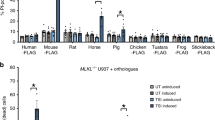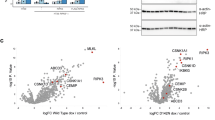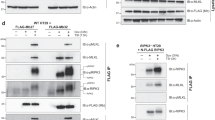Abstract
The Fas system has been extensively investigated as a model of apoptosis and the caspase cascade has been shown to be a characteristic mechanism of signaling of apoptosis. We have identified and purified a kinase that was activated after the stimulation of Fas on human thymoma-derived HPB–ALL cells. Partial amino acid sequencing of the purified kinase revealed it to be MST/Krs, member of the yeast STE20 family of protein kinases. MST/Krs was activated by proteolytic cleavage and proteolytic activation was blocked by the caspase inhibitor, Z-VAD-FK. A mutant MST with Asp→Asn replacement at a putative caspase cleavage site was resistant to either the proteolytic cleavage or the activation of the kinase activity. These findings suggest that proteolytic activation is one activation mechanism of MST and plays a role in apoptosis.
This is a preview of subscription content, access via your institution
Access options
Subscribe to this journal
Receive 50 print issues and online access
$259.00 per year
only $5.18 per issue
Buy this article
- Purchase on Springer Link
- Instant access to full article PDF
Prices may be subject to local taxes which are calculated during checkout
Similar content being viewed by others
Author information
Authors and Affiliations
Rights and permissions
About this article
Cite this article
Lee, KK., Murakawa, M., Nishida, E. et al. Proteolytic activation of MST/Krs, STE20-related protein kinase, by caspase during apoptosis. Oncogene 16, 3029–3037 (1998). https://doi.org/10.1038/sj.onc.1201840
Received:
Revised:
Accepted:
Published:
Issue Date:
DOI: https://doi.org/10.1038/sj.onc.1201840
Keywords
This article is cited by
-
Discovery of IHMT-MST1-39 as a novel MST1 kinase inhibitor and AMPK activator for the treatment of diabetes mellitus
Signal Transduction and Targeted Therapy (2023)
-
MST1 deletion protects β-cells in a mouse model of diabetes
Nutrition & Diabetes (2022)
-
Neratinib protects pancreatic beta cells in diabetes
Nature Communications (2019)
-
MST1 is a key regulator of beta cell apoptosis and dysfunction in diabetes
Nature Medicine (2014)
-
Regulation of caspase pathways by protein kinase CK2: identification of proteins with overlapping CK2 and caspase consensus motifs
Molecular and Cellular Biochemistry (2011)



